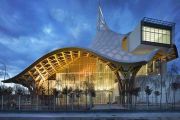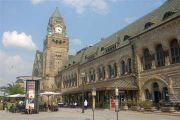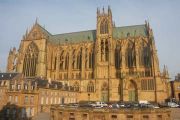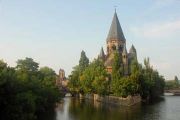Capital of the Lorraine region, in northeastern France, Metz has a particularly rich history and boasts many monuments. The recent opening of an outpost of the Pompidou Centre makes this green and architecturally eclectic city even more attractive.
[ Practical ]
Getting there
- By road
330 km from Paris on autoroutes A4 and A31.
- By train
TGV from Paris Est to Metz. Journey takes approximately 1 hour and 20 minutes.
Lodging
- Hotels
Hôtel de la Cathédrale
Grand Hôtel de Metz
Hôtel du Théâtre
La Citadelle
Le Royal
Hôtel Bristol
Cecil Hôtel
Hôtel Métropole
All Seasons Metz Centre
Restaurants
Les Amis de Saint Louis
Le Magasin aux Vivres
La Table de Pol
L’Etude
Chez Moi
L’ Aloyau
L’ABC
Le Chat Noir
El Theatris
Restaurant Maire
Le Pont Saint Marcel
L’Ecluse
L’Angélus
Le Mirabellier
La Marmitte de l’Olivier
Au Pampre d’Or
George – A la Ville de Lyon
Getting around
It’s possible to go everywhere by foot.
Centre Pompidou Metz
1 parvis des Droits de l’Homme.
57000 Metz.
Open Monday and Wednesday from 11 am to 6 pm, Thursday and Friday from 11 am to 8 pm, Saturday and Sunday from 10 am to 6 pm..
Admission : €7.
Tel : 0387153939
www.centrepompidou-metz.fr
Musées de la Cour d’Or
2 rue du Haut Poirier.
5700 Metz.
Open every day except Tuesday from 10 am to 5 pm.
Admission : €4,60.
Tel : 0387201320
musees.metzmetropole.fr
Information
- Moselle Tourist Office
Tel : 0387215390
www.moselle-tourisme.com
- Metz Tourist Office
Tel : 0387555376
www.tourisme-metz.com
Until recently slightly off the beaten tourist paths, Metz might well become one of the most visited French cities. Since May 12th, the capital of Lorraine region is indeed home to a branch of the Pompidou Centre, the celebrated Parisian modern art museum. Situated next door to the railway station, on the edge of a contemporary garden, the building is easily recognizable by its asymmetrical Chinese hat like roof topped by a spire and punctured by upper galleries that stick out like airport pods.

 Centre Pompidou © R. Halbe Centre Pompidou © R. Halbe
|
 Temporary exhibitions Temporary exhibitions
Designed by Japanese and French architects Shigeru Ban and Jean de Gastines, this new museum has no permanent collection. It only hosts temporary exhibitions regularly renewed showing works on loan from its motherhouse and international institutions. Four vast areas are available for this purpose and allow the display of large size installations that can’t be presented in the rooms of the Parisian building.
Thanks to the new East TGV, it takes only 1 hour and 20 mn to get there from Paris while Germany, Luxembourg and Belgium are only 40 to 60 km away. So, it makes this destination for modern art enthusiasts a feasible day trip for many people. However, Metz boasts so many other sights that it would a pity to not spend more time wandering around. Founded more than 3000 years ago, the city has been besieged and conquered several time but always rose from the ashes like a phoenix and its rich heritage reflects this turbulent past.

 Metz railway station © T.Joly Metz railway station © T.Joly
|
 19th century urban planning 19th century urban planning
Near the Pompidou Centre, the Imperial District – or New Town – thus reminds of the 1870 – 1918 years, a period in which Lorraine was annexed by Germany. Created by order of the Emperor Wilhelm II and featuring a blend of neo Romanesque, neo gothic, neo Renaissance, Art deco and Art nouveau architecture, it’s one of the finest examples of late 19th century – early 20th century town planning and the municipality of Metz applied for the classification of the district on UNESCO's World Heritage List. The most noteworthy building is the railway station, an impressive neo Romanesque structure measuring 300 m in length, 200 m in width, crowned by an 80 m high clock tower and decorated with statues and bas-reliefs symbolizing power or depicting scenes of everyday life. But it was also built with an eye for the functional and the pragmatic as it was dotted with14 platforms in order that 25 000 soldiers could board trains within 24 hours. Considered as a town of major strategic importance by the Germans, Metz was also endowed with new fortifications and was by 1914 the world’s largest fortified compound.
 Old fortifications Old fortifications
Unfortunately, these late 19th century urban developments also led to the destruction of older buildings such as the Gallo – Roman and medieval walls. So, only a few towers have survived, as well as the superb Porte des Allemands (German Gate), looking like a miniature castle, that held out against Charles Quint’s 60 000 soldiers during the 1552’s siege. Likewise, the citadel built by the French between the 16th and 19th has been largely destroyed. The most remarkable remains are found in the Esplanade district where the former arsenal has been transformed in a performance hall by famous Catalan architect Ricardo Boffil while a 16th century bastion now houses a 4* hotel named La Citadelle. These two buildings stand beside one of France’s oldest church, Saint-Pierre-aux-Nonnains, dating back to the 7th century, and the neo Renaissance Governor Palace, comprising 106 rooms, built at the end of the 19th century to accommodate the commander in chief of the German Army.
 Medieval buildings Medieval buildings
Situated in a triangle shaped by the confluence the Moselle and Seille rivers, the old districts have nevertheless survived the ravages of time. With its row of arcaded medieval houses, the Saint Louis square has hardly changed since the 15th – 16th centuries when Metz was a prosperous free city where French writer Rabelais stayed to escape the censorship of the French King. Spreading out around it is a grid of mainly pedestrianised narrow and cobbled streets lined with cloisters, medieval and Renaissance houses, churches, cloisters, shops and bars.
As to the main monuments, they stand on the Sainte Croix hill, the cradle of the town. Set up in a monastery, a medieval tithe barn and a Gothic house, the Musées de la Cour d’Or holds collections linked to the history of the city, in particularly beautiful Roman and Merovingian artifacts. It gets its name from the gilded palace of the Merovingian kings of Austrasia that stood on the same spot.

 Saint-Etienne cathedral © T.Joly Saint-Etienne cathedral © T.Joly
|
 Stunning cathedral Stunning cathedral
Oldest civil building still existing, the Hotel Saint Livier is a mansion dating from the 12th century, home to Lorraine's contemporary art centre, the FRAC, which hosts cutting-edge exhibitions. Set up at the time of Louis XV, the place d’Armes is surrounded by three fine classical 18th century buildings : the guard-house, now the tourist office, the town hall and the former parliament. On the last side stands the superb Saint-Etienne gothic cathedral constructed with yellow limestone that when bathed in the sun, give off a warm, golden glow. It is known as “The Lord’s Lantern” because of its stained glasses, which cover 6 500 sq meters, the largest area in France. Created from the 13th to the 20th century, they include panels by famous contemporary artists Marc Chagall and Jacques Villon, brother of Marcel Duchamp.
Right in front, a large covered market occupies an U-shaped neoclassical building that was intended to be the bishop's palace until the French Revolution intervened. It’s one of the best places to buy a variety of regional specialties. You can even eat here.

 Petit Saulcy island/ Temple Neuf © T.Joly Petit Saulcy island/ Temple Neuf © T.Joly
|
 Garden city Garden city
Only a few steps away, the Moselle river and the islands formed by its numerous arms where sail squadrons of swans are another highlight of the city. The nearest one, the Petit Saulcy island, is also the most beautiful thanks to old stone bridges, a picturesque early 20th century neo Romanesque protestant church reflecting in the waters and the Place de la Comédie bordered by an ensemble of 18th century classical buildings including a charming theatre, the oldest still in use in France. Besides, the neighborhood boasts gastronomic restaurants and offers great views over the old city and the cathedral that are lighted at night. Nearby there is also a pleasant marina, where pedal and rowboats are available for rent, as well as several parks with paths along the riverbanks. But it is not specific to this area. Metz is also called “The Green City” or “Garden City” because of its over 470 hectares of green areas – 37 sq meters per inhabitant - making it the greenest city of its size in France
July 07, 2010
Thierry Joly 

|



